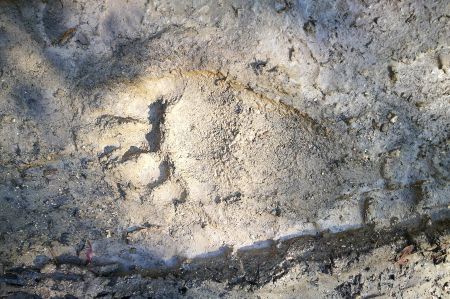Bear tracks in Jablanica Mountains above Lake Ohrid
- Written by Portal Editor
The Ohrid Lake, as mentioned several times, is one of the oldest lakes in the world and is the last survival of a former ocean that reached the Vienna basin 15 million years ago.
Different kinds of sharks, as a sample, were residents in this ocean, whose fossil teeth were found near Brunn am Gebirge - Haie.
The secluded location of the Ohrid Lake is responsible for the development of the unique Ohrid trout, the living whitefish, the buds, the red-eye, as well as some serpent species which are up to 30 million years old. Similar species can only be found in Lake Baikal. The European eel is also known for its exceptional reproduction cycle: it swims thousands of kilometers from the Sargasso lake to Lake Ohrid, where it lasts for ten years in the depths of the lake. When the eel attains its sexual maturity, he returns to his birthplace in the Atlantic; there it heaps and dies, his descendants repeat the cycle for thousands of years.
Another species can be meet very closely during the hikes in the Jablanica Mountains, because the seclusion of the mountain world is the home of brown bears. The only one of the eight bear species on earth, which is found in the core areas of Europe, is the brown bear. Once, bears were widespread throughout Europe, Asia and North America. In Germany and many other countries of Europe the large mammals were to be found across the country. Old place names such as "Bear Canyon" or "Bear Cave" are still in use today. The brown bears have been mercilessly hunted by the people of Europe and have died out in many densely populated areas in Europe many centuries ago already. However, in some regions the largest predators in Europe survived to this day. In many countries in Europe bears are now under strict protection, but not everywhere the numbers are again increasing.
We traveled from Vevčani to a so far not really noticed Roman fortification near the Via Egnatia between Elbasan and Ohrid starting from Camping Rino, when we saw the fresh tracks of a bear on the forest path. On the road in a group, we had little thought about a possible meeting, too loud was the behavior of the participants. However, we were amazed at how close to the human settlements the shy animals came. On the way back from the Roman fortification the traces were too clear, because a large rubbish container was the target of the bear. Overturned and the contents spread far, was the result of the presence of our bear. Well, we did not have a photo of the bear, but instead from his footprints.
The brown bear loves forests, not much changed landscapes and sparsely populated areas. The conditions are ideal in Europe, for example, in Scandinavia. More then 3,000 bears live in Sweden. They are found in many regions across the country, but not in the southern quarter of Sweden. The animals are also found around Stockholm. Bears also live in Norway but significantly less than in Sweden. There are probably just around 100 brown bears in Norway.
There are also many brown bears in the western Balkans. The number of bears in the former Yugoslavia is estimated to be more then 3,000. The largest number, about 1,000, probably live in Croatia. The large mammals usually live in the interior of the country, bears are rarely seen on the Adriatic coast. Nearly 500 bears exist in small Slovenia. Brown bears also live in the other countries of the region (Bosnia-Herzegovina, Macedonia, Serbia, Albania, etc.). In Bosnia, with 900 bears, the largest number of Croatia in the former Yugoslavia is likely to be counted. In Albania there are around 400 brown bears, 300 to 500 in Serbia and 100 in Macedonia.
Around 500 bears live in the north of Greece. Other sources speak of only 100 or 300 bears in Greece. They live in the Rhodope Mountains (also: Rhodopes or Rodopi) on the border with Bulgaria. Other bears in Greece inhabit the Epirus Mountains south of Albania near the Adriatic Sea. The main town of the area is Ioannina. In the rest of the country there are no brown bears, either around Athens, or on the Peloponnese, or on islands such as Crete or Corfu.
Please read as well:
Autumn Hike along the Jablanica Mountain range
Back at Lake Ohrid - Morning impressions at the lake side
-
 Traces of bears at Jablanica Mountain
Traces of bears at Jablanica Mountain
Traces of bears at Jablanica Mountain
Traces of bears at Jablanica Mountain
-
 Traces of bears at Jablanica Mountain
Traces of bears at Jablanica Mountain
Traces of bears at Jablanica Mountain
Traces of bears at Jablanica Mountain
-
 Traces of bears at Jablanica Mountain
Traces of bears at Jablanica Mountain
Traces of bears at Jablanica Mountain
Traces of bears at Jablanica Mountain
-
 Traces of bears at Jablanica Mountain
Traces of bears at Jablanica Mountain
Traces of bears at Jablanica Mountain
Traces of bears at Jablanica Mountain
-
 Traces of bears at Jablanica Mountain
Traces of bears at Jablanica Mountain
Traces of bears at Jablanica Mountain
Traces of bears at Jablanica Mountain
-
 Traces of bears at Jablanica Mountain
Traces of bears at Jablanica Mountain
Traces of bears at Jablanica Mountain
Traces of bears at Jablanica Mountain
-
 Traces of bears at Jablanica Mountain
Traces of bears at Jablanica Mountain
Traces of bears at Jablanica Mountain
Traces of bears at Jablanica Mountain
-
 Traces of bears at Jablanica Mountain
Traces of bears at Jablanica Mountain
Traces of bears at Jablanica Mountain
Traces of bears at Jablanica Mountain
-
 Traces of bears at Jablanica Mountain
Traces of bears at Jablanica Mountain
Traces of bears at Jablanica Mountain
Traces of bears at Jablanica Mountain
https://www.alaturka.info/en/life/fauna/4168-bear-tracks-in-jablanica-mountains-above-lake-ohrid#sigProId56ab2591f2

